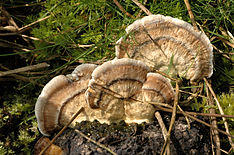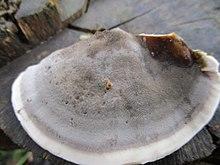| Bjerkandera adusta | |
|---|---|
 | |
| Scientific classification | |
| Kingdom: | |
| Division: | |
| Class: | |
| Order: | |
| Family: | Meruliaceae |
| Genus: | Bjerkandera |
| Species: | B. adusta |
| Binomial name | |
| Bjerkandera adusta (Willd.) P.Karst. (1880)[1] | |
Bjerkandera adusta, commonly known as the smoky polypore or smoky bracket,[2] is a species of fungus in the family Meruliaceae. It is a plant pathogen that causes white rot in live trees, but most commonly appears on dead wood. It was first described scientifically as Boletus adustus by Carl Ludwig Willdenow in 1787.[3] The genome sequence of Bjerkandera adusta was reported in 2013.[4] The species is inedible.[5]

Bjerkandera adusta bottom view, pores (tubes) are visible
Chemistry
Because Bjerkandera adusta produces enzymes that can degrade polycyclic aromatic hydrocarbons, such as those used in synthetic textile dyes, there has been research interest in investigating the fungus for possible use in bioremediation.[6][7]
References
- ^ Karsten, P. (1879). "Symbolae ad mycologiam Fennicam. VI". Meddelanden Af Societas Pro Fauna et Flora Fennica (in Latin). 5: 15–46.
- ^ Ostry, M.E.; O'Brien, J.G.; Anderson, N.A. (2011). Field Guide to Common Macrofungi in Eastern Forests and Their Ecosystem Functions. Government Printing Office. p. 31. ISBN 978-0-16-088611-9.
- ^ von Willdenow CL. (1787). Florae Berolinensis Prodromus (in Latin). p. 392.
- ^ Ruiz-Dueñas, Francisco J.; Lundell, Taina; Floudas, Dimitrios; Nagy, Laszlo G.; Barrasa, José M.; Hibbett, David S.; Martínez, Angel T. (2013). "Lignin-degrading peroxidases in Polyporales: an evolutionary survey based on 10 sequenced genomes". Mycologia. 105 (6): 1428–1444. doi:10.3852/13-059. hdl:10261/96105. PMID 23921235.
- ^ Phillips, Roger (2010). Mushrooms and Other Fungi of North America. Buffalo, NY: Firefly Books. p. 317. ISBN 978-1-55407-651-2.
- ^ Singh, R.; Eltis, L.D. (2015). "The multihued palette of dye-decolorizing peroxidases". Archives of Biochemistry and Biophysics. 574: 56–65. doi:10.1016/j.abb.2015.01.014. PMID 25743546.
- ^ Kadri, Tayssir; Rouissi, Tarek; Kaur Brar, Satinder; Cledon, Maximiliano; Sarma, Saurabhjyoti; Verma, Mausam (2017). "Biodegradation of polycyclic aromatic hydrocarbons (PAHs) by fungal enzymes: A review". Journal of Environmental Sciences. 51: 52–74. doi:10.1016/j.jes.2016.08.023. PMID 28115152.